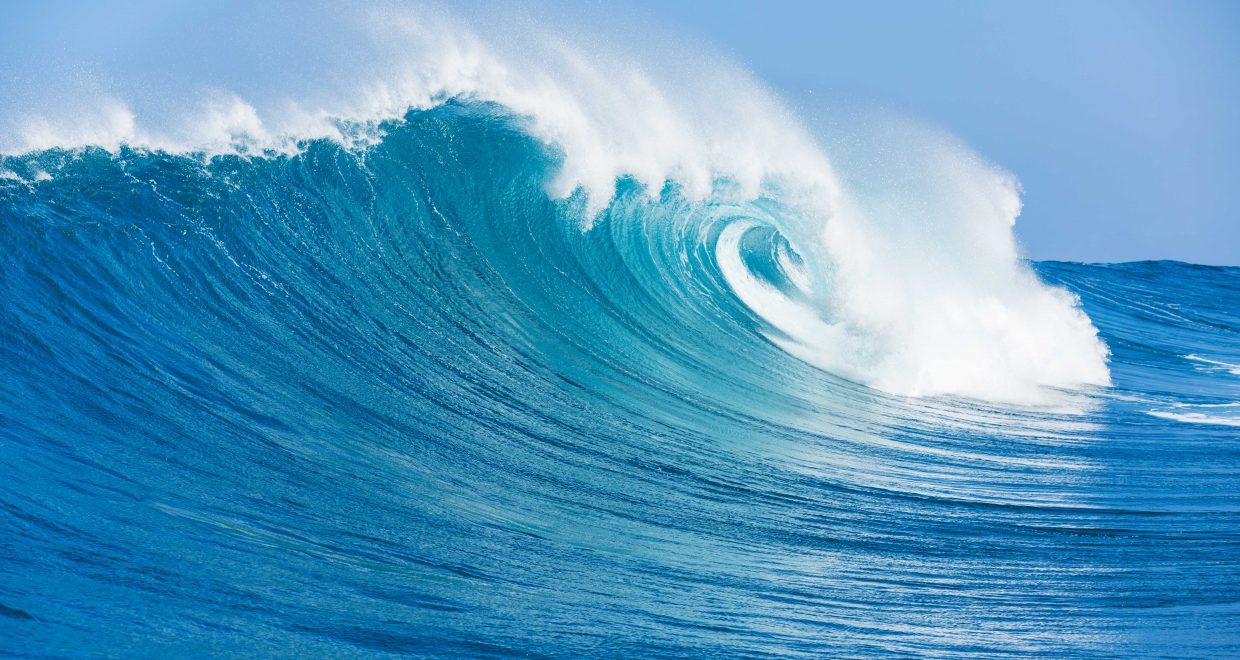Making waves in the world of renewable energy
Renewable sources of energy such as wind and solar power are becoming commonplace across the world, but yet it often seems that we are still searching for the renewable resource that will revolutionise the energy industry. Wave energy from the oceans is cited by many as exactly this resource, but we are yet to see a reliable and affordable solution materialise. A recent study in JFM has analysed the behaviour of wave energy systems with the hope that the new understanding will enable them to fulfil their vast potential.
The Italian city of Venice is as famous for its network of waterways as it is susceptible to the rising sea levels caused by climate change. This susceptibility has led to the construction of a mobile storm barrier consisting of articulated hollow gates fixed to the seabed. The major purpose of these gates is to protect the city from flooding, but by attaching a series of oscillating wave surge converters (OWSC’s) to the gates, the energy from the tides could in theory be harvested and used to power the city. Analysing this hypothetical multipurpose barrier, we see an interesting conundrum. From the point of view of a flood protection system, resonant behaviour from the tides is to be avoided as the large oscillations it causes increase the risk of the barrier being overcome by flood waters. However, from the perspective of energy generation, aligning the motion of the gates with the resonant frequencies of the tides is highly beneficial as the larger amplitude motion creates more electricity. In fact, the amount of energy generated increases approximately linearly with the frequency of the motion of the gate (Figure 1).
Figure 1

Compared to other methods of ocean wave energy capture, such as buoys or oscillating columns, OWSC’s are much more efficient, although previously the efficiency analysis had only been done using linear theories with any non-linear phenomena simply neglected. Michele et al. were able to solve the fully non-linear equations of motion for the system using a perturbation technique and then analysed the solution using methods from dynamical systems. Ultimately, they were able to show that such a system could become chaotic due to the non-linear interaction between two modes which results in an increase in the efficiency of the system. The period-doubling bifurcation associated with the classical logistic map can be seen in a plot of the frequency versus amplitude (Figure 2).
Figure 2

Michele hopes that this new knowledge will be used by engineers when designing future OWSC’s. By building the system to resonate with the frequency of the incoming sea waves, not only will the amplitude of the resonant oscillations increase, they can also be made to interact with the non-linear frequencies to further boost energy production. In other words, now that we know about the existence of the non-linear frequencies we can design systems to hit several resonant frequencies at once, rather than just the main one of the incoming waves.
The Venice tidal barrier provided the perfect test geometry for the study as the use of a multiple gate array allows for the required non-linear interactions to take place. Previous studies using only linear theory give a maximum efficiency of 0.5, where efficiency is defined as the power generated by the OWSC divided by the power of the waves across the width of the gate. The non-linear theory of Michele et al. sees this efficiency increase above 0.5, or perhaps even 1 as several waves collide with the gate from multiple angles (Figure 1).
With the success of the non-linear theory for a system of OWSC’s in a channel, the next challenge is to extend the work to a more general setting. If Michele and his colleagues are able to identify non-linear frequencies for the open sea, then ocean wave energy may just become the next big thing in the world of renewable energy.
Reference: Michele, Simone & Sammarco, Paolo & d’Errico, Michele. (2017). Weakly nonlinear theory for oscillating wave surge converters in a channel. Journal of Fluid Mechanics. 834. 55-91. 10.1017/jfm.2017.724.







Out of couriosity, in what does consist the non-linear therory proposed by Michele. In stochastic processes, we usally model the non-linearity part of the wave with the Detrended Fluctuation Analysis (sometimes). Is it something like that?